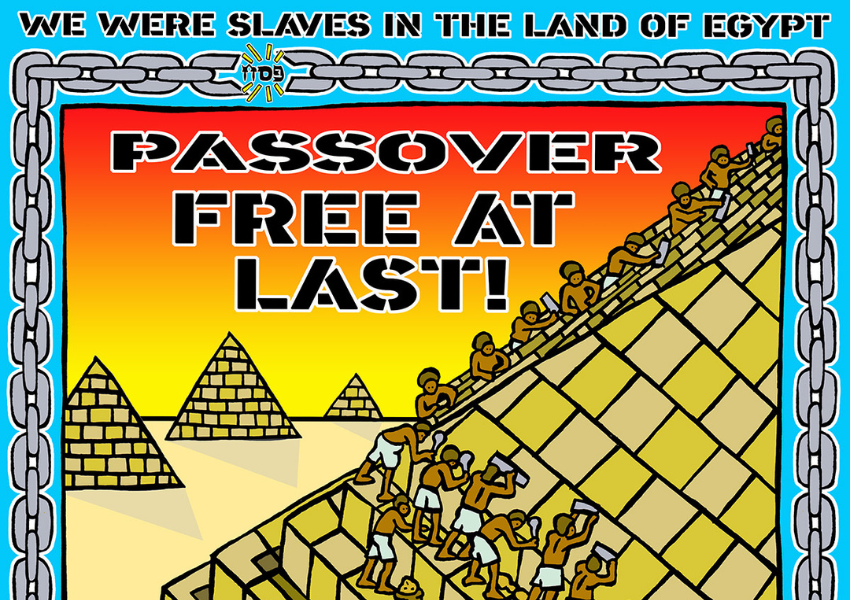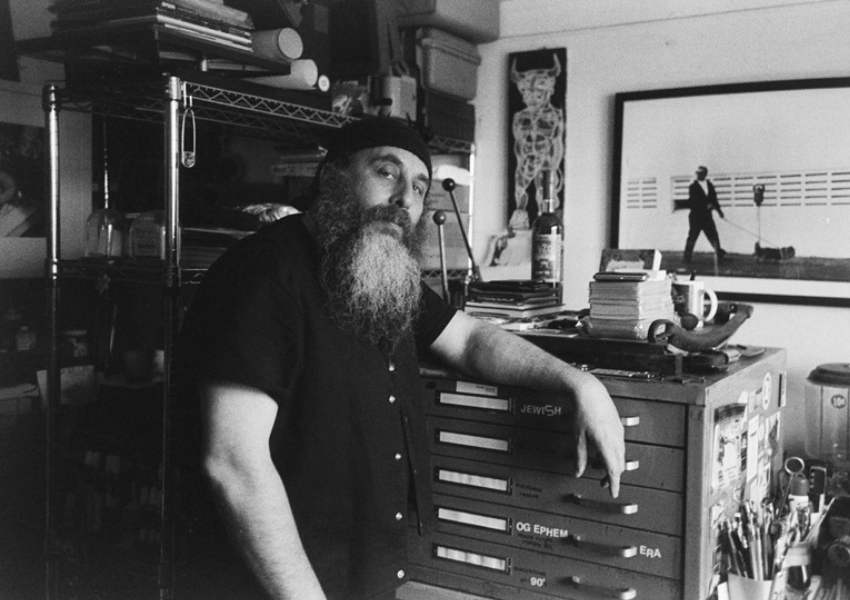Passover/Pesach Poster | Steve Marcus Poster Series
Published Mar 30, 2023

Passover/Pesach Poster

Passover, also called Pesach פֶּסַח, or the Holiday of Matzah חג המצות, is a major Jewish holiday and one of the three pilgrimages requiring every Jew to trek to Jerusalem where the Holy Temple stood. Passover requires the retelling of the Biblical story of the Israelites escaping from slavery in Egypt as described in the Book of Exodus. It occurs on the 15th day of the Hebrew month of Nissan and is observed with a ritual meal, called a Seder. Seder translates to “order”, and there is an order of this meal which includes eating symbolic foods, most famously matzah.
The Haggadah is the book used to guide the guests through the order of the meal’s 15 steps, which mirror the fifteen steps that lead into the Holy Temple. Rabbi Gamliel famously stated in the Haggadah that, “Whoever does not explain the following three symbols on Passover has not fulfilled his duty.” These symbols are Pesach (the Passover offering), matzah (the unleavened bread), and maror (the bitter herbs), all of which are represented in their place of significance on the Seder table. But what can we learn from these three symbols?
Leavened bread rises and is symbolic of ego. One must perform an external search for chametz in one’s home and may not have any chametz in their possession during Passover, but one must also do an internal search for these “crumbs”. Once the ego is nullified, they are then able to Pesach, or pass over, into a new frame of mind with a new attitude. But what is the litmus test? It’s the maror, the bitter herb represented by horseradish. This test determines their success in nullifying the ego and transcending to this new level of awareness. It is the bitterness of the maror that symbolizes the challenges and difficulties that test one’s actual change, as bitterness stems from one’s egotistical unfulfilled expectations. Without ego, there is no evaluation of good or bad, only acceptance and inner peace.
As we celebrate our collective liberation from slavery and oppression in Egypt, may we be strengthened to liberate ourselves from the individual slavery and misery of the human ego.
Chag Pesach kasher vesame’ach.
— Reb Simcha Yosef ben Yehuda Ha’Levi
AKA Steve Marcus, Artist
Passover/Pesach Poster (close up 1)

Passover/Pesach Poster (close up 2)

About the Poster Series

NYC Artist, Steve Marcus writes about his new series for the Jewish Arts Collaborative:
“There’s an old saying that a skilled laborer works with their hands, a craftsman with their hands and mind, but an artist works with their hands, mind, and heart. This trinity of the hands, mind, and heart is accessible for artistic manifestation by any human being, regardless of race, religion, ethnicity, sexual orientation, or gender. Within the mind-boggling diversity of the human population and its countless artists— now capable of tracing their ancestors’ origins to every corner of the globe— one may wonder, what makes art “ethnic”?
Ethnic art incorporates and expresses a specific people’s culture, history, and collective experience. When artisans and their work are both descended from a specific group’s said collective experience, and the artisan chooses to wrestle with the inner torment of the group’s reality with the hope of communicating the subtleties of their unique daily experience and thought processes, the subject of the work becomes the artisans themselves. The work can then be considered authentic “ethnic art”. However, not all art crafted by the hands of ethnic artisans can be classified as ethnic art. When craftspersons of distinct ethnicities create objects without ethnic content, the “ethnic” adjective refers to the artist and not the art. And if an artisan creates art that has ethnic content relating to an ethnicity that is not their own, then the ethnic adjective refers to the art and not the artisan. In this case, the artisan may be knowledgeable of the subject matter, so the art may mimic ethnicity, but it will not be informed by an authentic experience. The exploitation of that inner experience by someone from a separate culture amounts to “cultural appropriation”.
In the era of globalization, the ugliness of cultural appropriation has become rampant, as various “outside cultures” are now easily accessible with the assistance of the internet and social media. The digital-age specter of colonialism, imperialism and social Darwinism disseminates information and imagery at a dystopian pace. Consumers hijack distant cultures’ attitudes and style cues to mold themselves into the hipster approximations of cultures they have never experienced firsthand. This form of imitation is the stylistic manifestation of colonial imperialism and is helping to pave a bland and blind path toward a global monoculture.
Many descendants of the founders of monotheism are suckers for the global monoculture—no longer a nation within a nation, they are being absorbed into the matrix. The greatest existential threat to the Jewish people is the Jewish people themselves. The apologetic and sometimes dismissive attitude Jews have about being Jewish, to the point of assimilation, has left most Jewish artists and institutions struggling through a postmodern identity crisis. They’ve abandoned so much of their own intrinsic identity, creating art that begs for acceptance from their own tormentors. This current series of work for the Jewish Arts Collaborative expresses my own roots and culture by creating images for the annual festivals, holidays, and observances of the Jewish calendar, which proudly contain Jewish values as a celebration of authenticity. However, the artwork is not just a creative declaration of my own identity and beliefs but also created to inspire all people to celebrate and explore their own true identities in a creative rebellion that smashes falsehood and hatred. The quest for the truth will lead to oneness. Be strong and may we be strengthened.”
Steve Marcus (aka smarcus) has received honors and awards from the American Society of Illustrators and has several works in the art and American history collections in esteemed institutions, notably the Oakland Museum of California, The Jewish Museum of Florida – FIU, The Yiddish Book Center, The Harvard Library, Yivo Institute for Jewish Research and The Miami-Dade PLS. He is acknowledged as one of the Lower East Side’s most culturally influential residents in, “Jews: The People’s History of the Lower East Side” and his work is written about by professors from Ohio State University, Tulane University, Florida State University, Harvard University and in scholarly books published by Duke University Press, The University of Texas Press and the Florida International University. Steve is a member of the American Guild of Judaic Art.
This work was commissioned by the Jewish Arts Collaborative in 2022. Stay tuned for more posters in this series.
Other posters in this series: Tu BiShvat, Hanukkah, Purim. Stay tuned for more.
(Above: Photo by Ziggy York)
JArts’ mission is to curate, celebrate, and build community around the diverse world of Jewish arts, culture, and creative expression. Our vision is of a more connected, engaged, and tolerant world inspired by Jewish arts and culture.
Reflections
I spy…
It’s all in the details. What are some “hidden” details on the poster that catch your eye? How do these details illustrate the Passover story?
Assimilation
One of the central ideas of this series is grappling with assimilation and the abandonment of identity. How does the artist’s work embody authenticity and “creative rebellion”?
“Ethnic art”
What do you think makes a piece of art “ethnic”? How do you define “Jewish art”?
Want more?
Get curated JewishArts.org content in your inbox


